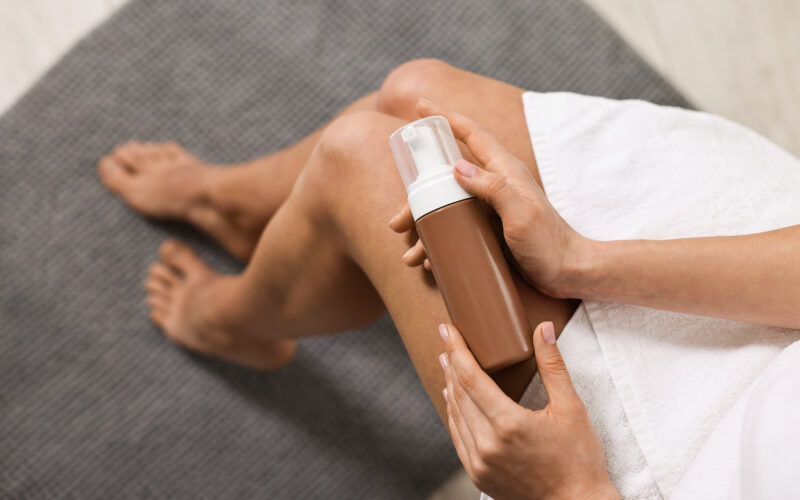As a natural strawberry blonde with freckles, my middle school years were full of kids teasing me about my nearly see-through skin. Playing soccer in the cold early spring resulted in me turning a splotchy shade of white and purple, and heaven forbid if I got hit in the leg by the soccer ball; that spot would turn a positively fluorescent orange. Being a lifeguard in high school and college, it took me a few years to realize I would never be a bronzed goddess like my coworkers, and I would joke about praying for the day my freckles would all join together and I’d finally be tan.
So a few evenings ago as I was slathering myself with fake tan, I paused to think, “what am I actually putting on my skin week after week?” Yes, I finally had the bronze glow I had always coveted, but at what cost?
In 2015, données from the National Health Interview Survey found that 17.7% of non-Hispanic white women between the ages of 18-49 were found to use “artificial” methods of tanning. Tanning lotion was the most common (15.3% of all women surveyed), followed by indoor UV tanning (12%), and then spray tanning (6.8%) [1].
Indoor tanning risks are quite well known these days, after over a decade of research. The skin’s exposure to UV radiation from either the sun or artificial light stimulates the melanocytes in the skin to produce melanin and darkening of the skin. This process releases free radicals, damaging DNA, and increasing the risk of skin cancer—the most commonly diagnosed form of cancer in the US with about 5 million people treated for it annually [1]. According to a Newsweek article, over 400,000 of those skin cancer cases are related to indoor tanning, and 6,000 of those cases are diagnosed as melanomas—the most deadly form of skin cancer [4].
In light of all that, sunless tanning can’t possibly be more harmful than indoor tanning, right? Let’s take a look at what sunless tanning actually is.
Self-tans: From Snow White to beach babe in one magic cream
Most sunless tanning products on the market contain dihydroxyacetone (DHA) as the main tanning agent—not to be confused with the beneficial Omega-3 fatty acid Docosahexaenoic acid (DHA) found in fish oil. DHA found in sunless tanning products is a type of sugar (think back to high school chemistry, the chemical makeup of normal table sugar is C6H12O6 and DHA is C3H6O3) that when it is put onto the skin, reacts to amino acids (building blocks of protein) that are in the outermost layer of skin called the stratum corneum.
This reaction has a name you might be familiar with if you love cooking—the Maillard reaction, the same Maillard reaction that turns white bread into golden toast, green coffee beans into a delicious espresso roast, or white onions into caramelized bites of heaven. That characteristic “fake tan” smell? That’s actually the Maillard reaction you’re smelling, though most brands try to cover it up with added fragrance [6].
While food undergoes a Maillard reaction when the sugars in the food come in contact with heat, the self-tanner DHA comes into contact with the amino acids in the stratum corneum, dying the skin cells that coveted shade of golden brown. Parts of the skin that have a thicker stratum corneum like elbows, knees, hands, and feet absorb more of the DHA, which is why for self-tanning novices, those areas tend to be a few shades darker than the rest of your body. Shedding of these outermost skin cells through normal daily exfoliation are the reason most self-tans only last about a week [3].
A deeper look into DHA: The active ingredient in self-tanning lotion
The FDA and the Scientific Committee on Consumer Safety in the EU have both evaluated the safety of DHA in skin products, finding that up to a 10% concentration “will not pose a risk to the health of the consumer” [5].
However, there is preuve showing that “in DHA-treated skin more than 180% additional [free] radicals were generated during sun exposure with respect to untreated skin” [2]. These tests measured the amount of free radical reactions in skin biopsies during exposure to UV radiation—the same test that sunscreens and UV filters undergo when testing effectiveness [2]. That Maillard reaction between the DHA and the stratum corneum causes oxidation (breakdown at the molecular level) of the sugars in the DHA which lead to the free radical injury and resulting in advanced glycation end products (AGEs), also called glycotoxins.
One study in an integrative review published by the Journal of the Dermatology Nurses’ Association, found “Excessive amounts of AGEs in body tissues or circulation can [cause disease by] causing oxidative stress and inflammation, which can alter the structure and function of proteins […] AGEs have been associated with the development of chronic degenerative disorders such as Alzheimer’s disease, cardiovascular disease, and diabetes” [11].
This comprehensive review also recommends keeping topical DHA levels below 5%, and to avoid sunlight for the first 24 hours after applying to reduce the amount of free radical damage. One other étude in this review showed that after only 24 hours of exposure to DHA, there was a significant decrease in cell turnover—one of the hallmark characteristics of visibly aging skin [11].
DHA can release formaldehyde
The BAV Institute in Germany, a research lab that tests cosmetics and food, says very plainly on their webpage for DHA that “due to its chemical structure, DHA can release formaldehyde, especially at elevated storage temperatures of the cosmetic product” [7]. Other than smelling up the hallway outside high school anatomy classes while preserving specimens for dissections, formaldehyde is actually a very common product in household detergents, paint, plywood, medicine, and even fabric–even though it is a known human carcinogen. Used as a preservative (like in preserving compounds in some vaccines or keeping wood from rotting), formaldehyde is a banned cosmetic product in the European Union and, as of February 11, 2025, was put on the list of restricted substances in cosmetics in the US, set to take effect January 1, 2027 [12].
While there is no formaldehyde on the ingredients list of any fake tan I’ve seen, the journal Contact Dermatitis a publié un étude where they tracked the degradation of DHA and other chemicals in cosmetics that were exposed to a 104℉ environment over the course of 12 days. According to the results, “14 of the 19 products [tested] (74%) with DHA contained hidden formaldehyde compared with nine of the 111 products (8%) without DHA.” Included in the article was a 2023 finding from the consumer testing organization Stiftung Warentest: “all self-tanners with hidden formaldehyde contained DHA […and] hidden formaldehyde was found in 100% of 20 self-tanners, all containing DHA” [8].
While the idea of slathering yourself in something that can degrade into formaldehyde under the right circumstances doesn’t sound pleasant, what harm could it actually cause?
Formaldehyde and fertility
Note: most of the studies we’re about to look at are from the 1980’s when formaldehyde first came under major scrutiny and was first declared a possible carcinogen. This data has set the groundwork for what we know about formaldehyde and its effects on humans today and, while “old data,” is still accurate, we normally try to only use research from the past 10 years.
A 2011 systemic review notes findings made in 1975 that Russian women working in factories that made urea-formaldehyde resins were 2.5 times more likely to have menstrual disorders than women not working in those factories [9]. Similarly this review reported on a Finnish study from 1985-1995 on women working in a wood processing facility using formaldehyde as a type of wood glue measured their “fecundability density ration” (FDR) compared to women not working around formaldehyde. An FDR score below 1 means delayed conception. On average, the exposed women had an FDR score of 0.64, and those women who didn’t wear gloves when working in that environment had an even lower FDR score of 0.51 [13].
Un étude from 1975 on Russian women working in factories that made urea-formaldehyde resins were 2.5 times more likely to have menstrual disorders than women not working in those factories.
Unfortunately, it doesn’t just stop with menstrual disorders and having trouble conceiving. In 2017 the Department of Obstetrics for Guangzhou Women and Children’s Medical Center in China conducted a étude on 309 Chinese women of similar backgrounds. 118 women had miscarried during the first trimester of pregnancy while 191 delivered their pregnancies to term. The major difference that was found was that the levels of formaldehyde in the blood of the women who miscarried was significantly higher than those who carried to term. In fact, women with traces of formaldehyde found in their blood were 8 times more likely to miscarry their pregnancy [10].
Selon la European Scientific Committee on Consumer Safety guidelines, the amount of formaldehyde broken down from DHA and absorbed into the skin during one weekly self-tanning session is about a 0.91 parts per million (ppm) concentration. While that’s not as high as a dose of hair dye containing DHA (~1.19ppm), that’s still higher than the US Occupational Safety and Health Administration (OSHA) limit of 0.75ppm of formaldehyde in an 8-hour work day [15, 14].
The bottom line on fake tans, your health, and fertility
We’ve all heard the cliche saying “beauty is pain”–but that saying may actually be true when it comes to tanning of all forms. Whether you’re basking in the sun, laying in a tanning bed, getting a spray tan, or applying a seemingly innocuous tanning cream, there are health risks when it comes to becoming a bronzed beach babe.
This isn’t to say you need to throw out all your self-tanner immediately, but in light of our closer look at what tanning serums actually are (and more importantly, what they break down into), you pourrait want to save if for really special occasions (like a wedding or vacation) to minimize the effects fake tans may have on our skin health, fertility health, and pregnancy health.
I’ll volunteer as the shining beacon (positively radiant with my fluorescently pale skin) and do my best not to get caught up in the social contagion of golden goddesses on Instagram this summer, and I know you can do it, too.











